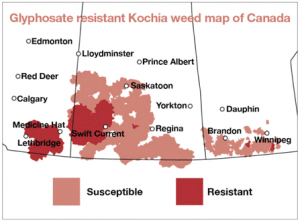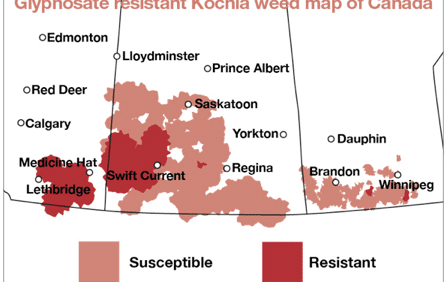Herbicide-resistant weeds are becoming more common across the Prairies. Kochia and cleavers are widely resistant to Group 2 herbicides. Kochia with resistance to Group 9 herbicide was detected on the Prairies in 2011 and have continued to expand rapidly. Group 1 resistant wild oats are in many fields. There are other examples. To reduce the risk of selecting for resistant weeds on your farm:
- Control weeds early. Herbicides are more effective on small weeds.
- Rotate herbicide groups.
- Rotate with crops that allow for a wide range of herbicide groups, and that have different seeding and harvest timing (winter cereals, for example).
- Use tank mixes. Hitting weeds with two modes of action effective on each weed reduces the risk of herbicide resistant weeds escaping and setting seed.
- Use the right herbicide at the right rate and apply at the right time. Cutting rates, for example, may reduce herbicide efficacy and increase weed seed return to the soil seed bank.
- Control weeds throughout the season to reduce the weed seed bank.
- Employ other Integrated Weed Management practices so herbicides are not the only method of weed management used on the farm. (See the Canola Enclyclopedia section on “Integrated Weed Management.”)

Further reading:
- Management tips for glyphosate-resistant kochia
- CropLife Canada’s Manage Resistance Now is an online resource developed through industry collaboration to help growers minimize the development of herbicide, fungicide and insecticide resistance on their farms
